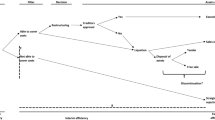Abstract
Although many works support creditor friendly bankruptcy laws, an evolution towards debtor friendly systems is at work. This paper proposes a theoretical ground to meet this paradox. It reconsiders the economic role of bankruptcy law by stressing on the courts’ production of information. It reveals that the transmission of a lenient signal by judges makes it possible to reduce the hazard that bad risks seek to avoid going on trial. Thus, it shows that debtor friendly bankruptcy laws are not systematically opposed to creditors’ interests. They reduce the risk of the economy and contribute to the improvement of the global efficiency.
Similar content being viewed by others
References
Aghion, P. (1998). Bankruptcy and its reform. The new Palgrave dictionary of Economics and the Law, London: Peter Newman, 1 A–D, 145–149.
Aghion, P., Hart, O., & Moore, J. (1992). The economics of bankruptcy reform. The Journal of Law, Economics and Organization, July, 523–546.
Allen, F. (1993). Stock markets and ressource allocation. In C. Mayer & X. Vives (Eds.), Capital markets and financial intermediation, Cambridge University Press.
Altman E. I. (1984). A further empirical investigation of the bankruptcy cost question. Journal of Finance, 39(4), 1067–1089.
Berkovitch, E., Israel, R., & Zender, J. F. (1994). The design of bankruptcy law: A case for management bias in bankruptcy reorganizations. Working paper, University of Michigan.
Berlin, M., John, K., & Saunders, A. (1996). Bank equity stakes in borrowing firms and financial distress. Review of Financial Studies, 9, 889–919.
Besancenot, D., & Vranceanu, R. (2005). Socially efficient managerial dishonesty. ESSEC Working Paper, May.
Blazy, R. (2000). La faillite-ÉlÉments d’analyse Économique, Economica.
Blazy, R. (2002). Credits, sanctions judiciaires et selections d’entreprises. Revue d’économie politique, no. 1, Février, 77–102.
Boyd, J., & Prescott, E. (1986). Financial intermediary coalitions. Journal of Economic Theory, 38, 211–232.
Brouwer, M. (2006). Reorganization in US and European bankruptcy law. European Journal of Law and Economics, 22, 5–20.
Carruthers B., & Halliday T. (1998). Rescuing business: The making of corporate bankruptcy law in England and the United States, Oxford University Press.
Chopard, B. (2005). La diversité des codes de la faillite nationaux: le point de vue de l’économie du droit. Problèmes économiques, mars 2005.
Diamond, D. (1984). Financial intermediation and delegated monitoring. Review of Economic Studies, 51, 393–414.
Diamond, D. (1991). Monitoring and reputation: the choice between bank loans and directly placed debt. Journal of Political Economy, 99, 689–722.
Eberhart, A. C., & Senbet, L. W. (1993). Absolute priority rule violations and risk incentives for financially distressed firms. Financial Management, 22(3), 101–116.
Fama, E. (1985). What’s different about banks? Journal of Monetary Economics, 15, 29–40.
FitchRatings (2006). Country specific treatment of recovery ratings – Revised.
FitchRatings (1999). Regimes, recoveries and loan ratings: The importance of insolvency legislation.
Guigou, J. D., & Vilanova, L. (1999). Les vertus du financement bancaire: fondements et limites. Finance Contrôle Stratégie, 2(2), 97–133.
Hashi, I. (1997). The economics of bankruptcy, reorganization, and liquidation. Russian and East Europe Finance and Trade, 33(4), 6–34.
Jensen, M.C., & Meckling, H. (1976). Theory of the firm: Managerial behavior, agency cost and ownership structure. Journal of Financial Economics, 3, 305–360.
La Porta, R., Lopez-de-Silanes, F., Shleifer, A., & Vishny, R. (1998). Law and Finance. Journal of Political Economy, 106, 1131–1150.
Lowitzsch, J. (Ed.) (2004). The insolvency law of Central and Eastern Europe- Eight countries screenings and a comparative analysis of cross border insolvency, BWV, Berlin.
Mizsei, K. (1994). Bankruptcy and the postcomlmunist economies of East-Central Europe. Russian and East Europe Finance and Trade, 30(2), mars–april 34–70.
Moody’s Investors Service (2001). Le régime français des faillites est moins favorables aux créanciers qu’aux débiteurs.
Mooradian, R. (1994). The effect of bankruptcy protection on investment: Chapter 11 as a screening device. The Journal of Finance, 49(4), 1403–1430.
Myers, S. C. (1977). Determinants of corporate borrowing. Journal of Financial Economics, 5, 147–175.
Rajan, R., & Winton, A. (1995). Covenants and collateral as incentives to monitor. The Journal of Finance, 50, 1113–1146.
Recasens, G. (2003). Faut-il adopter un système pro-créanciers de défaillances ? Une revue de la literature. Finance Contrôle Stratégie, 6(1), mars, 119–153.
Rivaud-Danset, D. (1995). Le rationnement du credit et l’incertitude. Revue d’Economie Politique, 105, 223–247.
Schumpeter, J. A. (1912). Théorie de l’évolution économique, Dalloz, Paris, 1935.
Sharpe, S. (1990). Asymmetric information, bank lending, and implicit contracts: A stylized model of customer relationships. The Journal of Finance, 45, 1069–1087.
Shleifer, A., & Vishny, R. W. (1992). Liquidation values and debt capacity: A market equilibrium approach. The Journal of Finance, 47(4), 1343–1366.
Standard & Poors (2005). Structured finance ratings. European Legal Criteria..
Stiglitz, J., & Weiss, A. (1981). Credit rationing in markets with imperfect information. American Economic Review, 71, 393–410.
Vilanova, L. (1997). Impact des effets de reputation sur l’incitation des banques à pratiquer une stratégie de soutien abusive. 14e Conférence Internationale de l’AFFI, Grenoble, 23–25 Juin.
Vilanova, L. (1999). La décision de prêt bancaire comme signal imparfait sur l’emprunteur: aspects théoriques et application au cas du soutien abusive. Thèse de doctorat en Sciences de Gestion, Université d’Aix-Marseille.
Webb, D. C. (1987). The importance of incomplete information in explaining the existence of costly bankruptcy. Economica, aout, 54, 279–288.
White, M. J. (1994). Corporate bankruptcy as a filtering device: Chapter 11 reorganizations and out-of-court debt restructurings. Journal of Law, Economics and Organizations, 10, 268–295.
Wruck, K. H. (1990). Financial distress, reorganization, and organizational efficiency. Journal of Financial Economics, 27, 419–444.
Author information
Authors and Affiliations
Corresponding author
Rights and permissions
About this article
Cite this article
Frouté, P. Theoretical foundation for a debtor friendly bankruptcy law in favour of creditors. Eur J Law Econ 24, 201–214 (2007). https://doi.org/10.1007/s10657-007-9033-7
Received:
Accepted:
Published:
Issue Date:
DOI: https://doi.org/10.1007/s10657-007-9033-7




